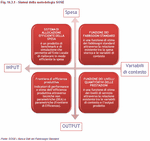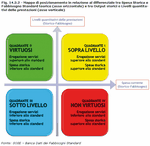Chapter 14
Standard needs: efficiency and equity in the expenditure of local italian authorities.
a focus on the Veneto region. (Note 1)
The enabling law on fiscal federalism (Italian Law 5 May 2009, no. 42) and the implementing provisions regarding the standard needs of local authorities (Municipalities, Provinces and Metropolitan Cities) issued with Italian Legislative Decree 26th November 2010 no. 216, offers Italy an important opportunity to modernise intergovernmental financial relations and improve the efficiency of the expenditure of local authorities. The reform process will allow equalising transfers to local authorities based on standard needs, abandoning the criteria of historic expenditure which is at the root of the inefficiencies in the distribution of intergovernmental transfers and the mismanagement of expenditure by local governments.
Assessing the financial needs of Local Authorities is the main component of all fiscal equalisation systems that govern the provision of equalisation transfers. With reference to this profile, OECD countries can be divided into two groups. The first group includes Australia, Denmark, Sweden, Finland and the United Kingdom, where the assessment of the financial needs of Local Authorities is determined based on the cost concept or standard need, defined through statistical and economic techniques. In the second group of countries, which includes Germany, Switzerland, Mexico, Spain and Italy, the financial needs of Local Authorities are calculated referencing historical expenditure.
The criterion of historical expenditure and standard needs are clearly distinguishable in terms of information and calculation requirements. The criterion of historic expenditure does not require the support of any statistical and/or econometric method and minimises the need for data: expenditure needs are determined in relation to what can be accounted in the last financial statement available or in a certain number of past financial statements. This approach, although having the undoubted advantage of simplicity has considerable drawbacks: random elements in the provision of flows involving derivatives, the risk of perpetuating inequity in the distribution of transfers over time and the possibility of financial non-sustainability in the long term. However, the criterion of standard needs for assessing the financial needs of Local Authorities rests on the idea that the financial requirements of a local authority are an expression of the territorial characteristics and social and demographic aspects of the resident population. Furthermore, the criterion of standard needs is dramatically different from the approach of historical expenditure as it has the purpose of measuring the differences in the financial needs of Local Authorities through the use of statistical and econometric techniques.
The OECD includes the adoption of the standard need calculation in the context of the best practices relative to the design of the local governments' financing systems. In particular, the advantage of overcoming the principle of historical expenditure and linking the provision of equalisation transfers to the standard need is two-fold and allows the combination of equity and efficiency. It is argued that the provision of transfers based on mathematical formulas that measure the needs of each authority is preferable to systems based on historical expenditure or the discretion of the central government because it ensures greater transparency of the transfer flows, more equity on the redistribution of resources and greater efficiency in public expenditure management thanks to the tightening of local governments' budget constraints.
Moreover, it should be noted that the process of determining standard needs will also allow a significant expansion of supporting information assets to the policy-maker. This information asset will be fundamental for the future determination of the essential levels of basic duties performance pursuant to article 117, second paragraph, letter m) and p), of the Constitution of the Italian Republic.
This chapter illustrates the work carried out by SOSE S.p.A. during the two year period 2011-2012 and the development prospects forecast for 2013. The text is articulated as follows: it outlines the regulatory framework of reference, reports the financing amounts involved in the process of determining needs, describes the key aspects of the methodology adopted by SOSE, summarises the results obtained over the two year period 2011-2012 relative to Veneto, and finally outlines future developments.
Assessing the financial needs of Local Authorities is the main component of all fiscal equalisation systems that govern the provision of equalisation transfers. With reference to this profile, OECD countries can be divided into two groups. The first group includes Australia, Denmark, Sweden, Finland and the United Kingdom, where the assessment of the financial needs of Local Authorities is determined based on the cost concept or standard need, defined through statistical and economic techniques. In the second group of countries, which includes Germany, Switzerland, Mexico, Spain and Italy, the financial needs of Local Authorities are calculated referencing historical expenditure.
The criterion of historical expenditure and standard needs are clearly distinguishable in terms of information and calculation requirements. The criterion of historic expenditure does not require the support of any statistical and/or econometric method and minimises the need for data: expenditure needs are determined in relation to what can be accounted in the last financial statement available or in a certain number of past financial statements. This approach, although having the undoubted advantage of simplicity has considerable drawbacks: random elements in the provision of flows involving derivatives, the risk of perpetuating inequity in the distribution of transfers over time and the possibility of financial non-sustainability in the long term. However, the criterion of standard needs for assessing the financial needs of Local Authorities rests on the idea that the financial requirements of a local authority are an expression of the territorial characteristics and social and demographic aspects of the resident population. Furthermore, the criterion of standard needs is dramatically different from the approach of historical expenditure as it has the purpose of measuring the differences in the financial needs of Local Authorities through the use of statistical and econometric techniques.
The OECD includes the adoption of the standard need calculation in the context of the best practices relative to the design of the local governments' financing systems. In particular, the advantage of overcoming the principle of historical expenditure and linking the provision of equalisation transfers to the standard need is two-fold and allows the combination of equity and efficiency. It is argued that the provision of transfers based on mathematical formulas that measure the needs of each authority is preferable to systems based on historical expenditure or the discretion of the central government because it ensures greater transparency of the transfer flows, more equity on the redistribution of resources and greater efficiency in public expenditure management thanks to the tightening of local governments' budget constraints.
Moreover, it should be noted that the process of determining standard needs will also allow a significant expansion of supporting information assets to the policy-maker. This information asset will be fundamental for the future determination of the essential levels of basic duties performance pursuant to article 117, second paragraph, letter m) and p), of the Constitution of the Italian Republic.
This chapter illustrates the work carried out by SOSE S.p.A. during the two year period 2011-2012 and the development prospects forecast for 2013. The text is articulated as follows: it outlines the regulatory framework of reference, reports the financing amounts involved in the process of determining needs, describes the key aspects of the methodology adopted by SOSE, summarises the results obtained over the two year period 2011-2012 relative to Veneto, and finally outlines future developments.
The source reference standard of standard needs lies, first of all, in Italian Law 42/2009, delegation of fiscal federalism and, subsequently, in the implementation of provisions issued with Italian Legislative Decree 25th November 2010 no. 216.
This set of rules marks the starting point of an important reforms process that, as described in article 1 of Italian Legislative Decree 216/2010, aims to provide equalising transfers to Local Authorities based on standard needs, thus abandoning the criterion of historical expenditure deemed to be the basis of the inefficiencies in the distribution of intergovernmental transfers and mismanagement of expenditure by local governments.
Italian Legislative Decree 216/2010 assigns the task of developing the methodology for determining the standard needs of Local Italian Authorities to the company 'SOSE Soluzioni per il Sistema Economico S.p.A.' This choice fully interprets the governance model considered by the OECD as among the most suitable for managing the equalising transfers: a model that sees the assignment of the technical and methodological aspects to an impartial organism in order to facilitate mediation between the central government and the Local Authorities. Furthermore, this choice exploits the statistical and econometric 'know-how' acquired by SOSE in the field of industry studies, heritage, which is fundamental to the design of methodologies for calculating standard needs, and the quantative levels of the performance of local authorities.
Italian Legislative Decree 216/2010 entrusts IFEL (Institute for Local Finance and Economy - Fondazione ANCI) with the responsibility of scientific collaborator and support to SOSE in the following activities; analysis and studies on local accounting and finance, preparation of questionnaires and administration to local authorities, development of the method of calculating standard needs, assessment of the adequacy of estimates produced, analysis of results, monitoring of the implementation process of standard needs. Furthermore, the technical tables of work see the active participation of UPI (Union of Italian Provinces), the 'Ragioneria Generale dello Stato' (General Italian Accounting Office) and ISTAT for which the fundamental contribution method is reported used for identifying and acquiring the information and data regarding the structural nature of the Local Authorities.
The adoption of the standard needs will produce a major change in the dynamic of funding the duties attributed to Local Authorities, determining the passing of several decades of funding based on the criterion of historical expenditure. Pursuant to article 2, paragraph 4, of Italian Legislative Decree 216/2010, 2013 is identified as the starting year of the transitional phase that, by virtue of paragraph 5 of the same article 2, is structured according to the following method and timeframe:
Furthermore, it is important to note that the new criterion of standard needs, essential for overcoming the dysfunctions of the criterion of historical expenditure, will produce the full effect of rationalisation in the context of an equalising system, based on the requirements of Italian Law 42/2009, including basic duties to be financed based on such standard need and non-basic duties to be financed based on fiscal capacity.
Finally, Italian Legislative Decree 216/2010 introduces, alongside standard needs, another element absolutely new to the panorama of Italian Local Authorities: the determination of the quantitative levels of performance that not only complete the calculation of standard needs but also represent an important information support for determining, by politicians, the essential levels of performance.
This set of rules marks the starting point of an important reforms process that, as described in article 1 of Italian Legislative Decree 216/2010, aims to provide equalising transfers to Local Authorities based on standard needs, thus abandoning the criterion of historical expenditure deemed to be the basis of the inefficiencies in the distribution of intergovernmental transfers and mismanagement of expenditure by local governments.
Italian Legislative Decree 216/2010 assigns the task of developing the methodology for determining the standard needs of Local Italian Authorities to the company 'SOSE Soluzioni per il Sistema Economico S.p.A.' This choice fully interprets the governance model considered by the OECD as among the most suitable for managing the equalising transfers: a model that sees the assignment of the technical and methodological aspects to an impartial organism in order to facilitate mediation between the central government and the Local Authorities. Furthermore, this choice exploits the statistical and econometric 'know-how' acquired by SOSE in the field of industry studies, heritage, which is fundamental to the design of methodologies for calculating standard needs, and the quantative levels of the performance of local authorities.
Italian Legislative Decree 216/2010 entrusts IFEL (Institute for Local Finance and Economy - Fondazione ANCI) with the responsibility of scientific collaborator and support to SOSE in the following activities; analysis and studies on local accounting and finance, preparation of questionnaires and administration to local authorities, development of the method of calculating standard needs, assessment of the adequacy of estimates produced, analysis of results, monitoring of the implementation process of standard needs. Furthermore, the technical tables of work see the active participation of UPI (Union of Italian Provinces), the 'Ragioneria Generale dello Stato' (General Italian Accounting Office) and ISTAT for which the fundamental contribution method is reported used for identifying and acquiring the information and data regarding the structural nature of the Local Authorities.
The adoption of the standard needs will produce a major change in the dynamic of funding the duties attributed to Local Authorities, determining the passing of several decades of funding based on the criterion of historical expenditure. Pursuant to article 2, paragraph 4, of Italian Legislative Decree 216/2010, 2013 is identified as the starting year of the transitional phase that, by virtue of paragraph 5 of the same article 2, is structured according to the following method and timeframe:
- the standard needs regard at least two thirds of the fundamental duties as referred to by article 3, paragraph 1, letters a) and b), determined before 31st March 2013, will enter into force in 2013, 'with a process of gradualism aiming to ensure the full capacity over the next three years';
- in 2013 the standard needs will be determined that will come into force in 2014, regarding all the fundamental duties, 'with a process of gradualism aiming to ensure the full capacity over the next three years'.
Furthermore, it is important to note that the new criterion of standard needs, essential for overcoming the dysfunctions of the criterion of historical expenditure, will produce the full effect of rationalisation in the context of an equalising system, based on the requirements of Italian Law 42/2009, including basic duties to be financed based on such standard need and non-basic duties to be financed based on fiscal capacity.
Finally, Italian Legislative Decree 216/2010 introduces, alongside standard needs, another element absolutely new to the panorama of Italian Local Authorities: the determination of the quantitative levels of performance that not only complete the calculation of standard needs but also represent an important information support for determining, by politicians, the essential levels of performance.
The basic duties subject to standardisation of the need, indicated in article 3 of Italian Legislative Decree 216/10, are listed in tables 14.2.1 and 14.2.2, respectively for the Municipalities and the Provinces of ordinary statute regions, with the indication of the amount of the resources corresponding to each duty and their contribution to the total. (Table 14.2.1)(Table 14.2.2)
(Figure 14.3.1) summarises the SOSE methods outlined to ensure efficiency and equity in the expenditure of Local Authorities:
The four pillars on which the method used rests are described below.
The possible methods of determining the expenditure needs of Local Governments are very diverse. The heterogeneity is not only due to the multiplicity of the techniques, but also to the way in which they are applied in the practical experiences of different countries, which adopt variations and particularities in relation to their specific requirements and to their historical and cultural traditions. In general, it can be said that there are as many techniques as there are countries adopting fiscal equalising systems.
The multiplicity of the existing approaches has made preliminary methodological choices necessary, guided by four principles: fairness and rigor from a scientific point of view, feasibility in their application, simplicity in the communication phase, representatively in terms of the capacity of the results representing the reality to which they refer. On the basis of these principles, the methodological approach developed by SOSE rests on two fundamental columns and, while somewhat incardinated in the context of best practice consolidated at an international level, aims to introduce various innovative elements that will be able to arouse the interest of the scientific community and offer a contribution to ongoing research in various countries for improving the procedures of estimating needs.
The first column is represented by the new construction of a database regarding the activities of Local Authorities through the processing and sending of questionnaires to Municipalities and Provinces that collect accounting information, quantative information about inputs and outputs of each service and information relative to the local territorial, social and economic context.
The second column is represented by the calculation of standard needs through the use of statistical and econometric techniques attributable to the RCA (Regression Cost Base Approach) method, which provides for the determination of standard needs through the estimation as a function of cost (pure RCA) or of a function of expenditure (RCA expenditure function) using linear multiple regression techniques. The discriminating element regarding the choice between cost function and expenditure function, is represented by the characteristics of the output variables available for measuring the level of final performance provided in the context of each function, in particular: the measurability or not of the final performances and the exogeneity of such performance compared to the decision-making autonomy of each local authority.
In the majority of cases, in which the output of local services provided will not be very measurable and/or endogenous with regards to the decision-making autonomy of each local authority, the assessment of standard needs will occur through the expenditure function estimate, which relates historic expenditure with the background variables of the demand and supply of local services subject to the analysis. Consequently, the cash need of every authority will be calculated through the allocation of a fund determined exogenously in relation to macro-financial compatibility. For example, this is the methodology already used for assessing the standard needs of the local police duties of Municipalities, labour market services of provinces and the general duties of both the authorities.
However, in some specific cases, for which it will be possible to overcome the problems of endogeneity and measurability of the output of local services, the assessment of standard needs will occur through the estimation of cost function, where historical expenditure is related to the output and the background variables of supply. Consequently, the cash need of each authority will be calculated using the product of the performance levels per unit cost of production, in this case the control of macro-financial assistance will occur through the establishment of the essential levels of performance by the central government. For example, this is the methodology that will be used to assess standard needs relative to child day care and social welfare for the elderly.
(Table 14.3.1) below summarises the choice between cost function and expenditure function which will be made based on the characteristics of the outputs provided in the context of the fundamental duties.
In the future, the joint analysis of the differences between historical spending and standard need and actual output (historical output) and the quantative performance levels (output standard) may become a powerful tool for identifying the nature of the policies appropriate to each specific local authority, given its positioning compared to the others.
For example, considering the exercise reported in (Figure 14.3.2) below, the underlying logic behind the positioning of Local Authorities in the four quadrants shown in figure 14.3.2 is based on the consideration that the standard output is, from a theoretical point of view, a measure of the potential demand that must be met by the standard need. Therefore, a red light turns on for the authorities placed in quadrants III and IV of the figure: the authorities positioned in quadrant III are called 'below level' as a standard need higher than the historical expenditure should also meet a higher potential demand (standard output) compared to the actual supply capacity (historic output); the authorities positioned in quadrant IV are called 'non-virtuous' because as well as facing a higher potential demand than the actual supply, they have a historic expenditure higher than the need. Both these groups of authorities should be placed under observation: the 'below level' authorities to verify that they will actually supply higher levels of service through obtaining greater financial resources and the 'non virtuous' entities to verify the very probable presence of serious inefficiencies.
However, the authorities placed in the two upper quadrants get a green light: those placed in quadrant II, called 'virtuous', which have a potential demand lower than that currently met and a standard need higher than historic expenditure, should be, therefore, the authorities to be used as a benchmark for identifying best practice; finally, the authorities placed in quadrant I, called 'above level' are those that, with a historic expenditure higher than the standard need, also offer a higher level of service than the potential demand. Therefore, these authorities should be able to independently fund the actual service levels beyond the potential demand or reduce the service level in line with need.
The techniques proposed in literature for forming such evaluations and rankings differ in several respects.
First of all, the so-called 'frontier' and 'non-frontier' approaches are distinguished. The first measures the efficiency of the various production units compared to a reference 'optimum' (which can be provided for by the estimation of a frontier of theoretical productive possibilities or by the best result achieved in the context of the sample of the production unit considered); the second measures efficiency compared to the average results of the sample used.
Furthermore, the technique used can be 'parametric', in the event in which both the estimation of a production or cost function is provided for, or 'non-parametric' in the event in which this estimate is not made and the frontier is identified by specifying some properties which must be satisfied by the points belonging to it.
Finally, the measures of stochastic efficiency and deterministic efficiency will be distinguished according to the fact that the techniques used allow or not, at least in principle, the stochastic factors to be taken into account which can affect the results of the production units regardless of their degree of efficiency.
The non-parametric procedure known as Data Envelopment Analysis (DEA) allows the assessment of the efficiency of a productive unit (DMU - Decision Making Unit) relative to a given set of productive units chosen for comparison, estimating the production frontier as a linear envelopment of the input - output data relative to individual businesses.
In economic literature, 'productive efficiency' of a business means:
Opencivitas is an online too for exploration, benchmarking and simulating the data of Municipalities and the Unions of Municipalities and Provinces, helping to improve the organisation of their duties and/or services, directing strategic planning towards efficiency and the reduction of expenditure.
Opencivitas allows Local Authorities to display their data and be able to compare it with other authorities with similar characteristics (for example: class of inhabitants, organisational model, virtuous authorities).
- the function of Standard Needs, an estimation function of the standard needs through the relationship existing between historical expenditure and background variables;
- the function of the quantative levels of performance, a function of the levels of services through the relationship existing between the background variables and the output produced;
- the frontier of productive efficiency, a system of performance indicators and estimates of the productive efficiency produced through non-parametric techniques (DEA) or parametric techniques (Efficiency frontiers);
- an allocation system of efficient expenditure, a benchmark and simulation product which allows Local Authorities to re-allocate expenditure in an efficient way.
The four pillars on which the method used rests are described below.
The first pillar: the standard needs method
The first pillar is represented by the standard need methodology, agreed with IFEL and UPI and approved at the COPAFF (Joint Technical Commission for the implementation of fiscal federalism).The possible methods of determining the expenditure needs of Local Governments are very diverse. The heterogeneity is not only due to the multiplicity of the techniques, but also to the way in which they are applied in the practical experiences of different countries, which adopt variations and particularities in relation to their specific requirements and to their historical and cultural traditions. In general, it can be said that there are as many techniques as there are countries adopting fiscal equalising systems.
The multiplicity of the existing approaches has made preliminary methodological choices necessary, guided by four principles: fairness and rigor from a scientific point of view, feasibility in their application, simplicity in the communication phase, representatively in terms of the capacity of the results representing the reality to which they refer. On the basis of these principles, the methodological approach developed by SOSE rests on two fundamental columns and, while somewhat incardinated in the context of best practice consolidated at an international level, aims to introduce various innovative elements that will be able to arouse the interest of the scientific community and offer a contribution to ongoing research in various countries for improving the procedures of estimating needs.
The first column is represented by the new construction of a database regarding the activities of Local Authorities through the processing and sending of questionnaires to Municipalities and Provinces that collect accounting information, quantative information about inputs and outputs of each service and information relative to the local territorial, social and economic context.
The second column is represented by the calculation of standard needs through the use of statistical and econometric techniques attributable to the RCA (Regression Cost Base Approach) method, which provides for the determination of standard needs through the estimation as a function of cost (pure RCA) or of a function of expenditure (RCA expenditure function) using linear multiple regression techniques. The discriminating element regarding the choice between cost function and expenditure function, is represented by the characteristics of the output variables available for measuring the level of final performance provided in the context of each function, in particular: the measurability or not of the final performances and the exogeneity of such performance compared to the decision-making autonomy of each local authority.
In the majority of cases, in which the output of local services provided will not be very measurable and/or endogenous with regards to the decision-making autonomy of each local authority, the assessment of standard needs will occur through the expenditure function estimate, which relates historic expenditure with the background variables of the demand and supply of local services subject to the analysis. Consequently, the cash need of every authority will be calculated through the allocation of a fund determined exogenously in relation to macro-financial compatibility. For example, this is the methodology already used for assessing the standard needs of the local police duties of Municipalities, labour market services of provinces and the general duties of both the authorities.
However, in some specific cases, for which it will be possible to overcome the problems of endogeneity and measurability of the output of local services, the assessment of standard needs will occur through the estimation of cost function, where historical expenditure is related to the output and the background variables of supply. Consequently, the cash need of each authority will be calculated using the product of the performance levels per unit cost of production, in this case the control of macro-financial assistance will occur through the establishment of the essential levels of performance by the central government. For example, this is the methodology that will be used to assess standard needs relative to child day care and social welfare for the elderly.
(Table 14.3.1) below summarises the choice between cost function and expenditure function which will be made based on the characteristics of the outputs provided in the context of the fundamental duties.
he second pillar: the methodology of quantative levels of performance
The second pillar also includes the definition of a methodology aimed at determining the quantative levels of performance or standard output. Econometric techniques will also be used in this case, using the estimation of a function that relates historic output with the background variables of the supply and demand of local services subject to analysis. The latter is an extremely important exercise, for both the purposes of determining the essential levels of performance and the service objectives to be assigned to local governments. A requirement much discussed in politics and academia, but never answered in a clear way from a methodological point of view.In the future, the joint analysis of the differences between historical spending and standard need and actual output (historical output) and the quantative performance levels (output standard) may become a powerful tool for identifying the nature of the policies appropriate to each specific local authority, given its positioning compared to the others.
For example, considering the exercise reported in (Figure 14.3.2) below, the underlying logic behind the positioning of Local Authorities in the four quadrants shown in figure 14.3.2 is based on the consideration that the standard output is, from a theoretical point of view, a measure of the potential demand that must be met by the standard need. Therefore, a red light turns on for the authorities placed in quadrants III and IV of the figure: the authorities positioned in quadrant III are called 'below level' as a standard need higher than the historical expenditure should also meet a higher potential demand (standard output) compared to the actual supply capacity (historic output); the authorities positioned in quadrant IV are called 'non-virtuous' because as well as facing a higher potential demand than the actual supply, they have a historic expenditure higher than the need. Both these groups of authorities should be placed under observation: the 'below level' authorities to verify that they will actually supply higher levels of service through obtaining greater financial resources and the 'non virtuous' entities to verify the very probable presence of serious inefficiencies.
However, the authorities placed in the two upper quadrants get a green light: those placed in quadrant II, called 'virtuous', which have a potential demand lower than that currently met and a standard need higher than historic expenditure, should be, therefore, the authorities to be used as a benchmark for identifying best practice; finally, the authorities placed in quadrant I, called 'above level' are those that, with a historic expenditure higher than the standard need, also offer a higher level of service than the potential demand. Therefore, these authorities should be able to independently fund the actual service levels beyond the potential demand or reduce the service level in line with need.
The third pillar: the methodology of the productive possibility frontier
The third pillar has the objective of setting up a procedure that may, in the future, improve the efficiency of expenditure through measuring productive efficiency (technical and allocative) of each authority by using both deterministic techniques such as Data Envelopment Analysis, and stochastic techniques such as Stochastic Frontier Analysis which allow, from different angles, the assessment of the ability of individual authorities to transform inputs and outputs. Furthermore, improving the efficient of expenditure may also be achieved through the insertion of 'objective' variables when estimating standard need, in order to introduce rewards to authorities that express 'virtuous' behaviours directly within the estimation of need.The techniques proposed in literature for forming such evaluations and rankings differ in several respects.
First of all, the so-called 'frontier' and 'non-frontier' approaches are distinguished. The first measures the efficiency of the various production units compared to a reference 'optimum' (which can be provided for by the estimation of a frontier of theoretical productive possibilities or by the best result achieved in the context of the sample of the production unit considered); the second measures efficiency compared to the average results of the sample used.
Furthermore, the technique used can be 'parametric', in the event in which both the estimation of a production or cost function is provided for, or 'non-parametric' in the event in which this estimate is not made and the frontier is identified by specifying some properties which must be satisfied by the points belonging to it.
Finally, the measures of stochastic efficiency and deterministic efficiency will be distinguished according to the fact that the techniques used allow or not, at least in principle, the stochastic factors to be taken into account which can affect the results of the production units regardless of their degree of efficiency.
The non-parametric procedure known as Data Envelopment Analysis (DEA) allows the assessment of the efficiency of a productive unit (DMU - Decision Making Unit) relative to a given set of productive units chosen for comparison, estimating the production frontier as a linear envelopment of the input - output data relative to individual businesses.
In economic literature, 'productive efficiency' of a business means:
- in the space of the outputs, given the technology and the inputs, the correspondence between the output actually produced and the maximum output potentially producible;
- in the space of the inputs, given the technology and output level, the correspondence between the input quantity actually used and the minimum quantity potentially usable.
The fourth pillar: an allocation system of expenditure efficiency with a Business Intelligence model
Finally, the fourth pillar is aimed at constructing various Business Intelligence models (Opencivitas), with the purpose of providing Local Authorities with an innovative online information management tool with which to monitor the composition of their needs and the quantative performance levels, their performance in relation to the operating indicators of adequacy and therefore knowing their positioning compared to other authorities, with social focus on those similar or bordering.Opencivitas is an online too for exploration, benchmarking and simulating the data of Municipalities and the Unions of Municipalities and Provinces, helping to improve the organisation of their duties and/or services, directing strategic planning towards efficiency and the reduction of expenditure.
Opencivitas allows Local Authorities to display their data and be able to compare it with other authorities with similar characteristics (for example: class of inhabitants, organisational model, virtuous authorities).
Standard needs
In the two year period 2011-2012, the basic duties of the Municipalities for which the standard needs and the quantative levels of performance have been identified are the 'Local Police' and 'General administration, management and control' (equal to 35% of the total current expenditure of the six basic duties of the Municipalities), whereas for the Provinces the duties subject to standardisation are relative to the 'Field of economic development of labour market services' and 'General administration, management and control' (equal to 35% of total current spending of the six basic duties of the Provinces).With regards to the general duties of administration and the local police, the Municipalities of the Region of Veneto show a standard need higher than historic expenditure by 5.65%. (Table 14.4.1)
With regards to the duties of general administration, management and control and local police duties carried out by Municipalities, (Figure 14.4.1) below reports, by dimensional class, the allocation coefficients grouped by historic expenditure (recorded in Final Account Certificates of 2009) and the allocation coefficients grouped by the standard needs of Veneto Municipalities.
(Figure 14.4.2) In general, the small municipalities of Veneto, with a population up to 2,000 inhabitants show a lesser need on average compared to historic expenditure, whereas the municipalities of Veneto with over 3,000 inhabitants show a greater need on average with regards to historic expenditure. It should be noted that the small municipalities have significant diseconomies of scale. For example, from the analysis of technical efficiency (Note 2) made on registry services, a significant diseconomy of scale emerges with particular reference to the management of draft services (see (Figure 14.4.3)), a service that could be carried out in a centralised manner in order to ensure greater efficiency.
Analysis of the quantative levels of performance
With reference to general and the local police duties carried out by the Municipalities (Figure 14.4.4) shows the positioning map of the Veneto Municipalities with regards to the standard needs and the quantitative levels of performance, whilst figures (Figure 14.4.5) and (Figure 14.4.6) show the positioning of Veneto Municipalities with regards to the four quadrants of the map shown by figure 14.4.4, respectively per dimensional class and province. A large percentage of municipalities are 'above level', 'below level' or 'non virtuous', showing that there are large possibilities for improvement.
The 'virtuous' municipalities may be considered as 'benchmark' for the identification of best-practices, both on a level of supply of services, which is higher than the estimated demand using the analysis of quantity of services, and for levels of expenditure efficiency, historical expenditure is in fact lower than the standard need.
Measurement of productive efficiency - first estimation results
As an example, the first results of the estimation of productive efficiency of Veneto Municipalities is reported for Registry services, Civil State duties, Electoral duties, Draft duties and Statistical Service duties.Usually from an applicative point of view, there is no information about the ability to separate output and input for which the plurality of output in relation to the plurality of input has to be assessed simultaneously. In the specific case in question, however, the outputs (thus also the inputs) can be considered as separable because of the information obtained from the questionnaires completed by each Italian Municipality which show the time dedicated to the macro categories of output. Furthermore, this choice of analysis had the clear advantage of producing easier to read results for each individual macro output category, thus leaving the possibility of building a summary indicator in the second phase that would allow the overall performance to be assessed.
The technical efficiency analysis was therefore developed for each individual macro output category by parameterising the amount of inputs based on the information regarding the percentage of time dedicated to carrying out the activity in question by each Municipality.
Having been able to analysis each macro service individually in relation to their inputs, six efficiency points can be obtained for each Municipality.
This information is extremely interesting especially if used for making comparisons between nearby Municipalities, regional or provincial averages or reference benchmarks; for example (Figure 14.4.7) shows the comparison between a reference Veneto Municipality belonging to the dimensional class of 10,000-19,999 inhabitants with the average scores of the Municipalities, showing that the local authority in question has higher efficiency that the median value in the six macro services considered.
It is yet more interesting to assess the scores within a broader assessment scheme such as that suggested by the positioning map (see figure 14.3.2) defined on the basis of the standard needs and quantative levels of performance.
(Figure 14.4.8) shows that the results relative to technical efficiency are consistent with the partition shown in the positioning map (see figure 14.3.2), which shows how the 'virtuous' Municipalities have an optimal output and input ratio and that the input used is optimal even in terms of cost. This result is also important because, in a sector such as registry where output is not expandable like the choice of Municipality, the optimality for the Local Authority should be sought in terms of input, both as quantity and as price and in terms of economies of scale.
Once the efficiency estimations are obtained per single output, a composite indicator is constructed in order to summarise the efficiency assessments. (Figure 14.4.9)(Figure 14.4.10)(Figure 14.4.11)
Table 14.4.1

Figure 14.4.1

Figure 14.4.2
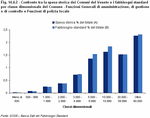
Figure 14.4.3
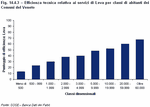
Figure 14.4.4
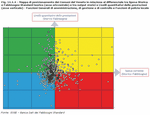
Figure 14.4.5
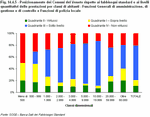
Figure 14.4.6
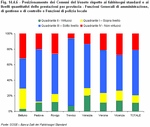
Figure 14.4.7
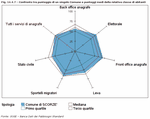
Figure 14.4.8

Figure 14.4.9
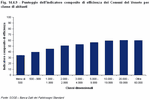
Figure 14.4.10

Figure 14.4.11
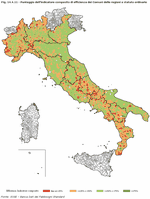
During 2013 the following fundamental duties of Municipalities will be analysed upon the completion of the standardisation process: Public Education Duties, Welfare Duties, Duties regarding traffic and transport and Duties regarding the management of the territory and the environment.
With regards to the provinces, during 2013, the following fundamental duties will be analysed upon the completion of the standardisation process: Public Education Duties, Duties regarding the Management of the Territory, Duties regarding Transport, Duties regarding Environmental Protection and Provincial Policing Services.
At the end of the process of constructing standard needs, instruments for improving the efficiency and equity of public spending of Local Italian Authorities will be available.
With regards to the provinces, during 2013, the following fundamental duties will be analysed upon the completion of the standardisation process: Public Education Duties, Duties regarding the Management of the Territory, Duties regarding Transport, Duties regarding Environmental Protection and Provincial Policing Services.
At the end of the process of constructing standard needs, instruments for improving the efficiency and equity of public spending of Local Italian Authorities will be available.











